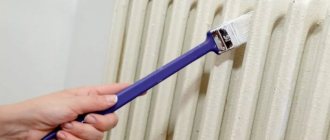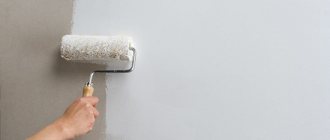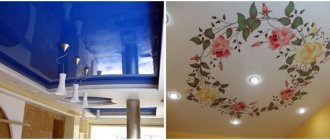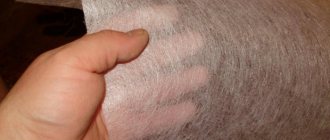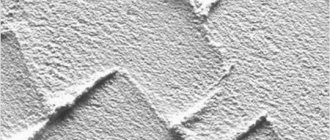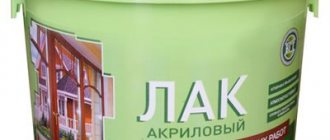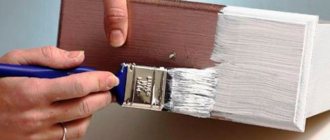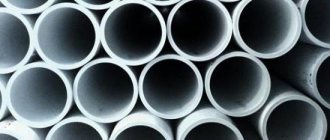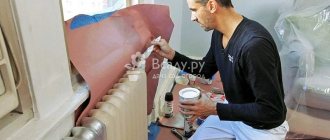How to paint polypropylene pipes - what paint?
To give plastic pipe products the desired color during their manufacture, various dyes are added to the source material.
There may be cases when the user, even before repairs, purchases blanks of the usual type, and he needs to paint them in a color suitable for the room. There is only one way to solve this issue - paint polypropylene pipes with a composition suitable for the design of the room.
Dye selection
Various types of coloring compounds can be used as a coating for polypropylene pipes, among which the following items stand out:
- standard paints used to protect metal surfaces;
- classic dyes intended for wall decoration;
- acrylic compositions, as well as mixtures designed specifically for plastic;
- polyurethane based dyes.
All of these types of coloring mixtures are commercially available and can be purchased at a hardware store.
Additional Information. When choosing a material suitable for painting polypropylene pipes, we advise you to contact the manager of a trade organization who will advise you on this issue.
When determining the coating application method for polypropylene, we proceed from the characteristics of the selected composition. Let's consider each of the options proposed above in more detail.
We recommend that you read: High-quality soldering of polypropylene pipes in hard-to-reach places
Preparatory work
Experts know very well how to properly paint plastic pipes. One of the main points of the process is the choice of dye. And strict adherence to the rules for applying the composition.
Paint in cans
This is the only way to achieve good and durable painting of the entire or just a separate part of the utility line.
When the decision is made to coat the pipes with paint, you need to choose a material. For a hot water system, you will need a special composition that is heat resistant. In addition, it is necessary to protect the floor and walls from paint drops.
How to choose paint?
The final result of your work depends not only on how the paint is applied to the metal, but also on how high quality it is and how suitable it is for such work. Paint for heating pipes must meet the following requirements:
- heat resistance from 100°C;
- resistance to abrasion and aggressive cleaning agents: pipes and radiators have to be washed quite often;
- non-toxic: during the heating process, the paint coating should not release odors or harmful substances into the air.
Types of paints
Today on the market you can find paints with different component compositions.
Acrylic enamels are produced on the basis of organic solvents, so painting pipes is inevitably associated with an unpleasant, pungent odor. However, the result will be a durable glossy finish that will retain its integrity and attractive appearance for a long time.
Alkyd paints are also in great demand for transforming pipes and radiators. Their downside is the pungent odor not only during the painting process, but also during operation. But the layer turns out to be really durable. Alkyd paints are distinguished by a richness of shades.
Water-dispersed enamels are attractive because they do not require much time to dry pipes and radiators, and the painting itself takes place without emitting a pungent odor, because these enamels do not contain caustic solvents.
Features of application
The choice of color for painting depends on preference. Some cover products to match the walls, while others make the mounted pipes more noticeable in the interior.
So, you can paint the pipes green, and then decorate them with artificial grape leaves. The result will be a grape vine that will look good in the kitchen if the entire room is designed accordingly.
Dyes for metal
Conventional metal paint has the following advantages:
- Low cost
- Availability, sold in all hardware stores.
- Easy to use because there is no need to prepare a base. The composition is simply applied and dries on the surface.
Often painting with conventional paints for metal substrates is carried out using a spray gun. The device allows you to evenly distribute the composition over the surface.
Using metal paint is accompanied by an unpleasant and pungent odor.
Such substances have a thick consistency. Therefore, the process must be performed as quickly as possible and additionally use a solvent to dilute the coloring composition.
Regular dyes
This method of painting polypropylene pipes has many negative aspects. The main disadvantage is the instability of coloring compositions when applied to heating pipelines.
Wall paint cannot withstand high heat. Therefore, the appearance of the created coating will deteriorate over time. The applied top layer will begin to peel off. Therefore, after some time you will have to repeat the painting process.
Using regular wall paint can reduce the visibility of pipes in the interior. After all, the system will have the same color as the wall structures.
Acrylic and polyurethane
Acrylic and polyurethane dyes belong to the group of “soft” compounds used at home for painting polypropylene pipelines. One of the components of such substances is a solvent. However, it does not cause any harm to the plastic.
Dyes based on acrylic and polyurethane allow you to paint polypropylene utility lines in any desired shade, as they are available in a wide color range. The ease of application of such compositions and the absence of odors have made the substances one of the popular means for painting pipe surfaces.
Acrylic and polyurethane dyes do not tolerate strong heat. Increasing the temperature of the painted surface may cause the paint layer to crack.
Therefore, acrylic and polyurethane substances should be used on pipes with the thickest walls possible. You need to pay special attention to this point if a heating system is created from pipe products.
Acrylic substances are applied exclusively to previously prepared surfaces. Typically a primer is used for processing. The required pre-treatment and limited temperature range of use have reduced the demand for these paints.
Special dyes
The main disadvantage of special paints for polypropylene pipelines is the high price. However, such compositions are no more durable than other commonly used materials for painting plastic engineering systems.
Solvents in special paints are not dangerous for the polymer from which pipe products are made. Such compositions are resistant to high temperatures. This allows them to be used for painting heating networks.
The drying time of special mixtures depends on the period of the year. If work is carried out on hot days in the summer, the painted pipeline will take longer to dry than in moderately cool weather.
Heat-resistant acrylic enamel
Odorless pipe paint is acrylic enamel. Due to the fact that it does not have a pungent odor, this enamel is an ideal paint and varnish material for work carried out inside residential premises. The painted surface becomes absolutely smooth and tactilely resembles plastic.
Since not all acrylic enamels are heat-resistant, when purchasing, you must carefully read the information regarding the temperature range of its use. The minimum value for using these enamels is 80 ºС.
A significant advantage of these paints is their drying time - for the first layer the value ranges from ten minutes to one hour, and from one to two hours for the second. To achieve a high-quality result, it is necessary to prime the surface to be painted. When carrying out work, it is necessary to avoid contact with moisture on the surface to be painted.
The consistency of acrylic resembles medium-thick sour cream; it does not spread, which eliminates the possibility of smudges. As stated above, this enamel should be applied to a previously primed surface in two layers. Violation of painting technology entails a significant deterioration in its quality.
The only drawback of using this material is its low resistance to mechanical loads.
Technology for painting polymer pipes
You can paint hot pipes made of polymer materials only after preliminary preparation. This is due to the fact that the glossy surface of the pipe prevents high-quality adhesion of the paint, and the coating will leave much to be desired, which will entail the need to apply several layers of paint. To prevent this, the surface of the pipe is cleaned with sandpaper.
Note! To process pipes, fine-grained sandpaper is used and the work is carried out without the use of power tools, since it is necessary to create only a slight roughness. Using a power tool can scrub the pipe too deep. During the heating season, polymer pipes can be painted only after sandpapering.
At the next stage, the pipes are wiped with a damp cloth after sanding to remove dust. Make sure the pipes are dry and clean before painting. After this, it is necessary to cover the floor and walls with protective material (film) to prevent paint from entering.
Preparing to paint iron pipes
Before you begin painting your water pipes, you need to determine what they are made of. Temperature also matters when choosing paints. In addition to paint and a brush, it will be impossible to do without sandpaper, gloves, a rag, a cuvette and primer. If the pipes are covered with old paint, it must be removed. After their surface is cleared of it, it will need to be sanded. This removes rust. After this, the surface of the pipes is degreased. Then all the garbage is removed, and fresh air is allowed into the room. Only after all this do the coloring begin. To prevent paint from dripping onto the floor, the brush must be held over some kind of vessel.
READ ALSO: Polypropylene pipe reinforced with fiberglass or aluminum, PP pipes for heating and plumbing, propylene
Paint selection
Now let's find out how to paint heating pipes. The final result will directly depend on choosing the right paint. When choosing paint, you must proceed from the requirements that apply to them. So, paint for heating pipes and radiators should have:
- high heat resistance (not lower than 100 degrees);
- abrasion resistance;
- not be toxic;
- resistance to aggressive environments.
Types of paints for heating pipes
There are paints on sale that are specifically designed for painting heating pipes:
- Acrylic enamels. They are produced on the basis of organic solvents, so painting heating pipes with their help and the drying process will be accompanied by a characteristic smell of the solvent. However, this justifies the end result - glossy shine and long service life.
- Alkyd enamels. When used, they also emit an unpleasant odor, which can later be felt when the heating system is operating. But the surface painted with such paint will be resistant to abrasion and high temperatures. It should be noted that manufacturers produce a fairly wide range of colors of this paint, which can satisfy any demand. Due to this, it is quite popular among consumers.
Heizkorperlack water-dispersion paint from the Dufa and Alpina brands is perfect for the restoration of radiators and heating pipes
- Water-dispersion paints. Painting heating pipes with water-dispersion paints that are specifically designed for this purpose is the most common choice. There is no specific smell when working with them, and they dry very quickly.
There is also oil paint, but now it is rarely used for such purposes.
What paint should I use? The final choice always remains with the consumer.
The best manufacturers of paints for painting heating pipes
Manufacturers, both domestic and foreign, produce a wide variety of paints that differ in color and quality. The price most often depends on the brand of paint and manufacturer. Among the countries producing paints that can satisfy virtually any taste, we should note Holland, Germany, Sweden, etc.
Thus, Radiator Paint enamel produced in Holland is white in color and after painting allows you to obtain a flawless glossy surface.
Heizkorperlack enamel and Mipatherm 600 paint produced in Germany are famous for their quality and do not require preliminary surface preparation. Within 3-4 hours after applying such paints, you can turn on the heating system, which is an advantage if repairs are carried out in winter.
Alkyd paint Elementfarg Alkyd produced in Sweden is used both as a primer and as a paint, which is very important, because There is no need for a separate primer. It is enough to just paint the surface in 2 layers.
Paint for plastic pipes
The choice of paint must be approached no less responsibly. Only by taking into account all the subtleties and choosing the right composition with which to paint a PVC pipe can you achieve a lasting color for many years. What ingredients to pay attention to:
- Finishing paints for walls and ceilings;
- Polyurethane dyes;
- Paints for metal surfaces;
- Acrylic.
Please note: Exterior concrete paint
Any of the options is suitable for PVC or ABS pipes with cold water or sewerage. When painting coolants, you need to choose a heat-resistant coating. Let's take a closer look at each type and decide what paint to paint the pipes with.
- Composition for walls and ceilings Among the advantages of use, it is worth noting the economy and the perfect match of colors in the interior. You don’t have to incur additional costs and use leftover paint after the renovation. But you cannot paint heat conductors with wall dye; it will soon peel off, since it is not intended for heating. You should also not use water-based paint, as its composition will destroy the plastic and will cause damaged pipes to be replaced over time. If you still decide to use an unsafe coating, you need to protect the surface with alkyd enamel. It will cover the plastic and prevent it from breaking.
- Paints with polyurethane Widely used for painting PVC and ABS pipes. The paint applies evenly, does not require more than one application and can withstand heat. Manufacturers offer a huge palette of colors, so it’s easy to choose the right one for your interior.
- Metal compositions Available and often used. The range of shades is amazingly diverse, the paint is easy to apply, does not require a second coat and can withstand heat. There is no need to prepare the surface in advance, apply a degreaser or primer. This saves time and money. But there are also disadvantages. Firstly, the consistency is thick. The mixture must be applied either very quickly and professionally, or in combination with a solvent. Secondly, there is a strong unpleasant odor that remains in the room for several days. For safety reasons, it is better to work with metallic paint in a respirator or at least with an open window. Otherwise, you can get nausea, dizziness, headaches and other delights of intoxication.
- Acrylic and special mixtures Intended by the manufacturer for painting plastic pipes. The paint composition does not damage the plastic, lays down in an even layer and lasts a long time. Of the minuses note:
- high cost of paint;
- service life comparable to previous materials.
Please note: Painting a slate roof
Before painting with acrylic, you must apply a layer of primer, then the result will exceed expectations.
- Pre-priming A method that allows the use of paint of any composition and manufacturer. The trick is to first apply an aerosol primer to the pipe, which is used when painting cars. You can buy it in auto stores, service stations or tire shops. The primer mixture in an aerosol is ready for use after shaking, does not require mixing or dissolving, is easy to apply and dries quickly. This method is also widely used by craftsmen.
Types of compositions
As mentioned earlier, each type of pipeline must have its own paint:
- The most capricious in this regard are heating wiring and radiators;
- External pipelines can be placed behind them;
- The least capricious, but also requiring attention, is the plastic wiring.
Painting heating wiring
- Currently, alkyd compounds are rightfully considered the first in popularity here . They form a strong, stable covering film, which has fairly good elasticity indicators, which is very important for surfaces subject to thermal expansion. Alkyd enamels have an enviable glossy sheen, but since they are based on an organic solvent, they smell strongly during application and require good ventilation.
- Water-emulsion or water-dispersed mixtures can theoretically be used . These paints apply well, have no odor, but they are not durable, plus they cannot be used everywhere for heating systems due to the fact that they have a heat-insulating effect.
- Acrylic and acrylate enamels are a relatively new product on the market and during this time they have gained a lot of fans . They can be either matte or glossy. They have high abrasion rates and good heat capacity. The coating itself is a thin, elastic layer of plastic polymer. The only serious drawback of these enamels can be considered the high price.
Types of products used
There are various product options that have the required characteristics.
Recently, oil paint for heating pipes is almost not used due to its disadvantages: pungent odor, long drying time, color changes under the influence of high temperatures.
The most common types of paints used for heating pipes and radiators are the following:
- acrylic enamels are strong, durable, giving the surface a glossy shine. However, their disadvantage is the unpleasant odor during the painting process, which, however, quickly disappears;
- alkyd enamels are resistant to high temperatures and abrasion, the coating is very durable and uniform. They are distinguished by a rich variety of shades. But their significant disadvantage is a pungent odor that can last up to three days and can be felt when the heating is on;
- water-dispersion emulsions should be chosen when odorless paint for heating pipes is needed. They are easy to apply, creating an even coating, dry quickly, and do not have an unpleasant odor. You should definitely check that the labeling indicates that it is intended for painting radiators.
Experts recommend
Any work requires a rational approach, including painting the heating system.
In order to do this professionally, with the least expenditure of effort, energy and money, you should take into account the advice of those who understand this:
- Before painting, you need to evaluate the heating system in order to choose the right coating that meets all the requirements of the latter.
- The next stage is preparation for painting: remove rust and old paint, clean it down to the metal base, and degrease the surface as much as possible. Apply the coating only at least six hours after stripping the metal, after using a primer. It can be called a base for paint, which ensures even application and better fixation of the coating. Otherwise, the heating system elements will quickly rust.
- The primer must match the structure of the future coating. Sometimes you can immediately choose it and paint for pipes from the same manufacturer. However, in the case of coating with anti-corrosion paints, which, by the way, can withstand heating up to six hundred degrees, a primer is not required.
Attention: Plastic pipes should only be cleaned using chemical methods. Mechanical processing will definitely ruin the material. But for pipes made of non-ferrous metal, on the contrary, mechanical cleaning methods are recommended.
- Still, despite the unique properties of alkyd enamels, it is better to paint radiators and pipes when they have completely cooled, so as not to repaint streaks and stains later. In this case, it is advisable to remove the battery, and if it doesn’t work, use a spray bottle or spray can for especially hard-to-reach places. This will save time and the work will be neat.
- If you paint the radiator, do it from top to bottom to prevent accidental drips on already finished surfaces.
- It is necessary to apply a protective coating on all sides, since over time, unpainted elements will begin to rust, which can lead to additional costs for protective enamels or a new battery altogether. And you need to apply the paint in several layers (about 2-3) with intermediate drying.
- When painting a cast iron battery, it is important to first remove traces of the old coating, otherwise the new one will quickly crack and peel off. Do not bypass the stage of priming the surface before coating. For cast iron systems, smooth foam rollers of small diameter are used for a more even application of enamel. A glossy coating will reveal all the unevenness of the radiator, but will quickly turn gray on cast iron. Here it is better not to choose white or light colors.
- If you like hammer enamel, prepare a radiator. The surface should be rough (skin can be used).
- Cheaper acrylic paint options turn yellow quickly. They should not contain chalk.
- To dilute acrylic paint, you need to have water, alcohol or vodka. You should not pour the solvent directly into a can of paint; it is better to do this in a separate container.
- Close the can of leftover paint tightly, otherwise it will dry out and become useless.
You already know how to paint copper heating pipes and others. Select the dye and apply it correctly, then the issue of painting will not bother you for a long time. The instructions will help you do everything correctly and avoid mistakes.
Instructions for painting plastic pipes
Contrary to popular belief that you only need to plaster the walls before painting the pipes, painting should be left for last. Otherwise, the not completely dry coating will collect all the small construction debris and lose its appearance. You need to carefully prepare plastic pipes for color changes:
- remove old paint with solvent or brush;
- clean and degrease the surface;
- Wipe dry and avoid moisture formation.
Prepared pipes.
Failure to comply with one of the points will lead to poor-quality dyeing and peeling of the material. Paint for polypropylene pipes can be applied by roller, spray or brush. The ideal result will be obtained by combining these methods. If the application of the selected material requires preliminary priming of the surface, you need to take into account the time it takes for it to dry completely. The soil mixture can be purchased at a hardware store and applied in a thin layer to the pipe, according to the instructions. After this, there is no need to use degreasers or other mixtures; you can proceed directly to painting. The paint application process itself does not require additional description; it is simple and accessible even to children. The main surface can be changed using a spray gun; hard-to-reach areas can be painted with a radiator brush. If the first layer is not saturated and neat enough, you can apply a second one after it dries and achieve the desired color.
Pay attention to: How to choose the right type and shade of paint for baseboards? Step-by-step instructions for coloring.
